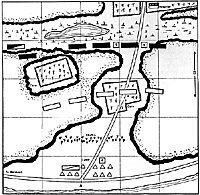BACKGROUND
Federal General Ulysses S. Grant was ordered on November 1st 1861 to make a demonstration against Confederate forces in the area of Columbus, Kentucky, the object of which was to stop them interfering in Union efforts to attack Rebel General Sterling Price in Missouri. Grant chose an amphibious assault on a small camp established near Belmont on the Missouri side of the Mississippi river directly opposite Columbus.
Bishop Polk, the senior Confederate in charge at Columbus on hearing of Grant's landing thought it was a feint for a larger attack on Columbus itself, and at first sent only token reinforcements, as the situation became clearer further units were dispatched and the result was claimed as a Rebel victory.
THE BATTLE
Grant moved out at dawn on the 7th and battle was joined around 1030, lasting until sunset. At first the Union troops swept all before them and pushed the Confederates back to the river bank, however on arrival at the now deserted camp the green recruits started to loot and pillage the compound, soon a fire started and it became clear to the watching gunners on the bluffs at Columbus that the enemy were in possession of the campsite, they promptly opened fire.
Although the result of this bombardment was negligible it coincided with a flanking maneuver by Rebel reinforcements and men rallied from the morning's fight. This situation soon sobered up the Yankees and Grant, spurning requests by some of his own men to surrender, typically fought his way back to the transports. In the confusion of the embarkation under fire, Grant himself was almost left behind and in order to escape jumped his horse onto a steamer which had turned back in the nick of time for him.
THE WARGAME
This lasts from 1030 until 1700 hrs (26 turns). The Columbus guns were at times engaged with the Union gunboats "Lexington" and "Tyler" and although successful against these should not really influence the land battle, it you disagree there were four batteries of mixed large calibers used, I do not know their composition nor do I know the types for the field artillery, early was in the West suggest 6 lb Smoothbores, 12 lb Howitzers or a mixture.
The Confederate field artillery were also very short of ammunition so should have a better than normal chance of running out of this commodity. Any routing units arriving at the riverbank should take an immediate morale check and if they fail should be removed as dispersed beyond rallying. Any Union regiments arriving at the Rebel camp not actively engaged in combat (i.e fire/melee) will halt and become disordered due to looting until withdrawn. Any units sheltering or moving along the riverbank will do so in disorder. Although is is apparent which Confederate units took part in the battle it is not clear where and when, therefore their positions are speculative. All troops are treated as green.
TERRAIN
All woods are rough, around the camp much of the forest was cut down to clear a field of fire from the Columbus batteries, the debris was then formed into an abatis to defend the camp. At the top of the map is a large pool of water surrounded by swamp and marsh. From the maps available it looks like the fields were surrounded by a substantial barrier which I have interpreted as stone walls, you could change these for fencing should you wish.
The riverbank between the road and the water should slope down considerable and offer complete protection unless fired at from the lip, and count as broken for movement. The corn is a difficult question, one source put the Rebel rout down to their 'exposed' position in a field (harvested perhaps9), others mention the corn as an encumbrance, if you opt for the former it is treated as broken ground, if the latter again broken but visibility as light woods with no saving throw. (Note: Astroturf door mats dry brushed with yellow ochre make excellent cornfields - courtesy Dale Bley).
DEPLOYMENT
As per the map. The Union gun battery was divided, four guns on the extreme left flank and two in the center.
VICTORY CONDITIONS
Union Major Victory -Loot camp and retire with 3/4 of force
Union Minor Victory -Loot camp and retire with 1/2 of force
Confederate Minor Victory -Save camp and destroy 1/2 of Federal force.
Confederate major Victory -Save camp and destroy 3/4 of Federal force
Anything else is a draw
ORDER OF BATTLE
UNION ARMY
Brigadier General U.S. Grant (Superior, +2)
1st Brigade Brigadier General J.A. McClernand (Average, + 1)
- 27th Ill. (600 men)
30th Ill. (600 men)
31 st Ill. (500 men)
2 Co's ill. Cavalry (200 men)
Battery '13' 1st Ill. Art. (6 guns)
2nd Brigade Colonel H. Dougherty (Average + 1)
- 22nd Ill. (600 men)
7th Io. (600 men)
CONFEDERATE ARMY
Brigadier General G.J. Pillow (Average, + 1)
- 11th La. (500 men)
13th Ark. (500 men)
12th Tenn. (500 men)
13th Tenn. (500 men)
Blythes Miss. (500 men)
Miss. & Tenn. Cavalry (200 men)
Watson's La. Battery (4 guns)
Arrive point 'A' 1030 hrs
- 21st Tenn. (500 men)
Arrive point 'B' 1200 hrs
- Brigadier General B.G. Cheatham (Superior, + 1)
14th Tenn. (500 men)
15th Tenn. (500 men)
Arrive point 'A' or 'B' 1500 hrs
- 2nd Tenn. (500 men)
22nd Tenn. (500 men)
Bibliography
The Civil War Dictionary - M.M. Boatner
The Road to Shiloh - D. Nevin
Battles & Leaders Vol. I - Ed Johnson &
Buell
Official Military Atlas of the Civil war - Ed.
Davis, Kirly & Perry

Back to The Zouave Vol VI No. 1 Table of Contents
Back to The Zouave List of Issues
Back to Master Magazine List
© Copyright 1992 The American Civil War Society
This article appears in MagWeb (Magazine Web) on the Internet World Wide Web.
Other military history articles and gaming articles are available at http://www.magweb.com